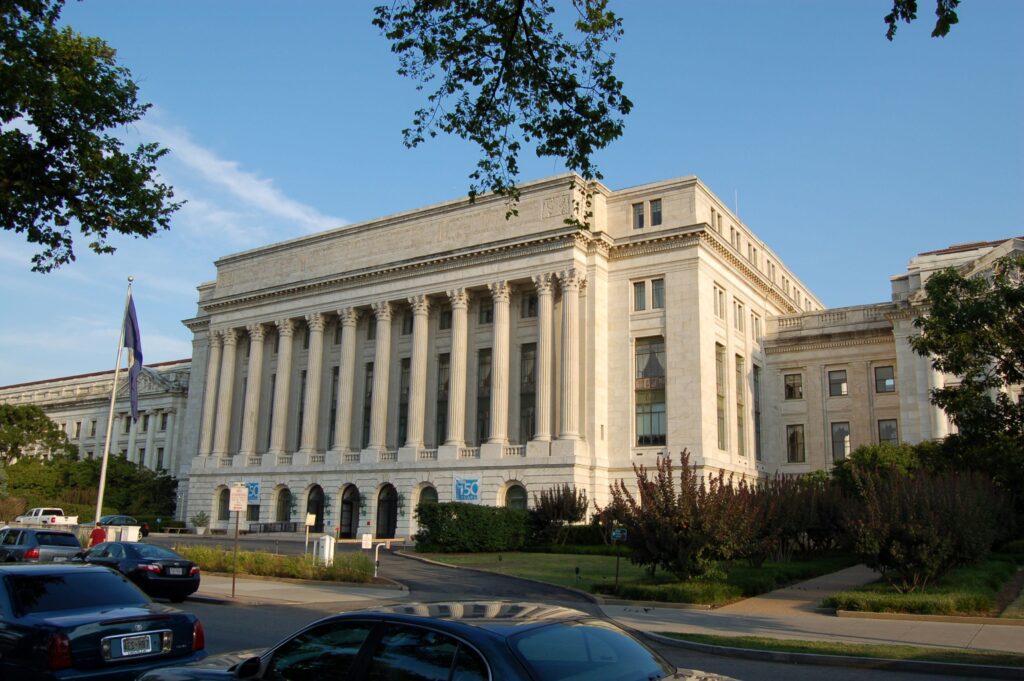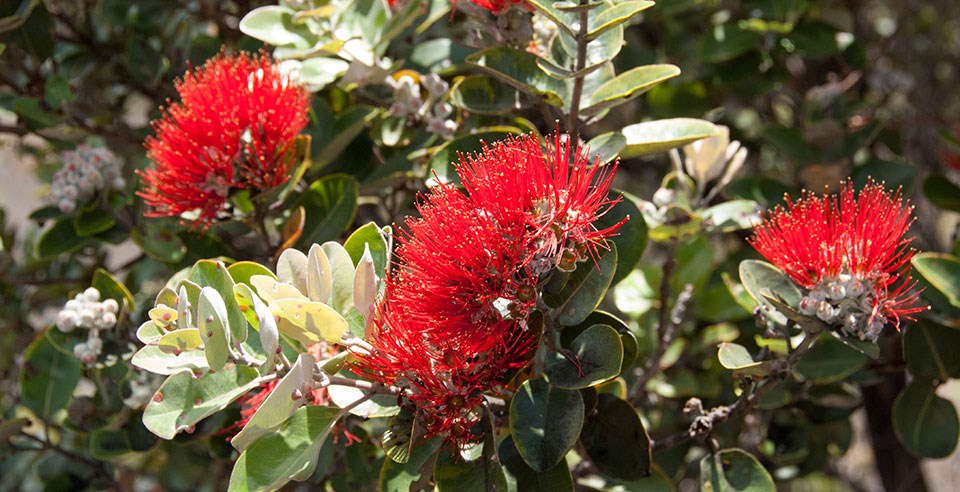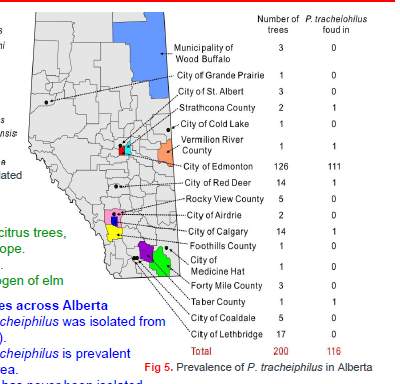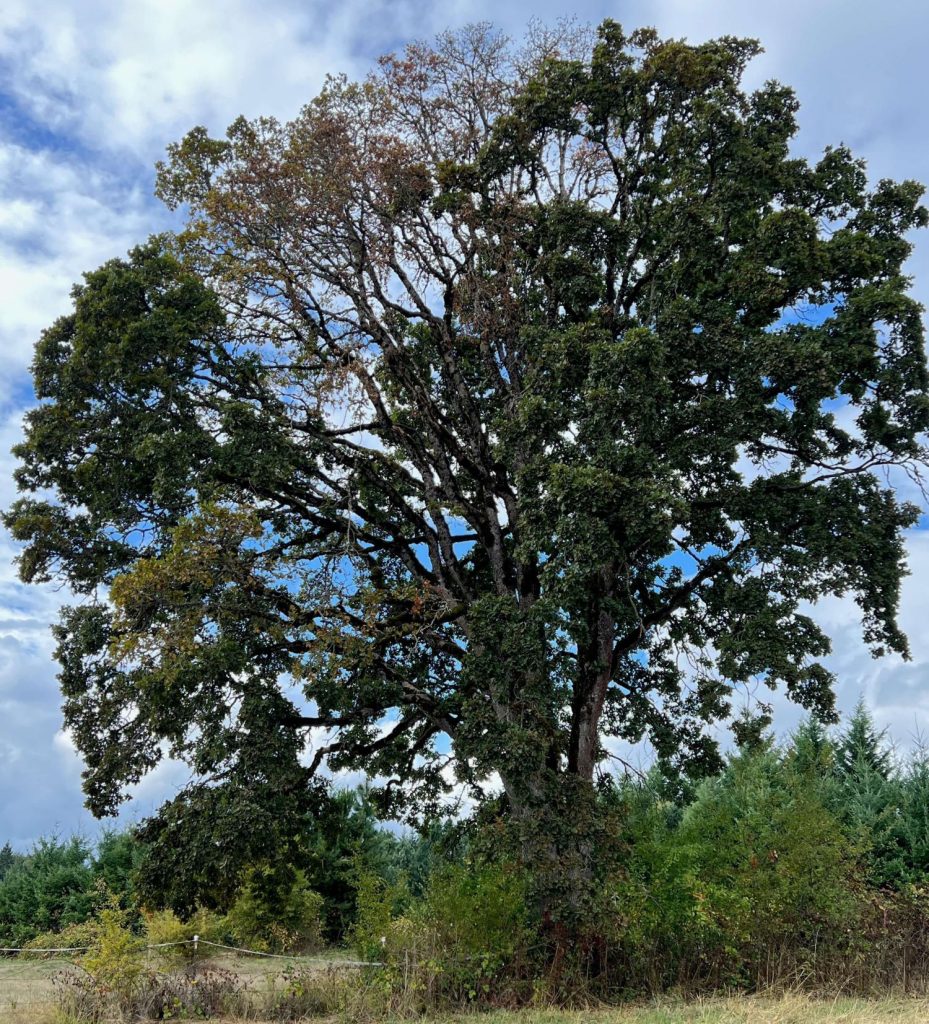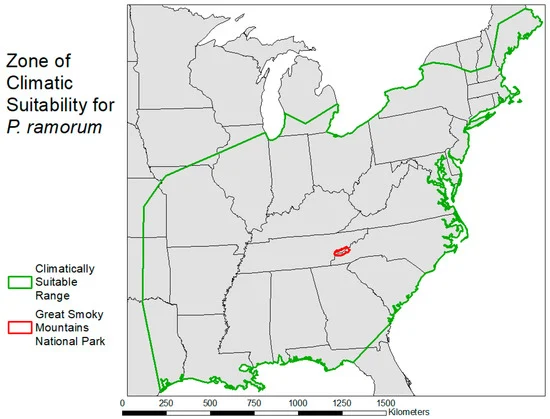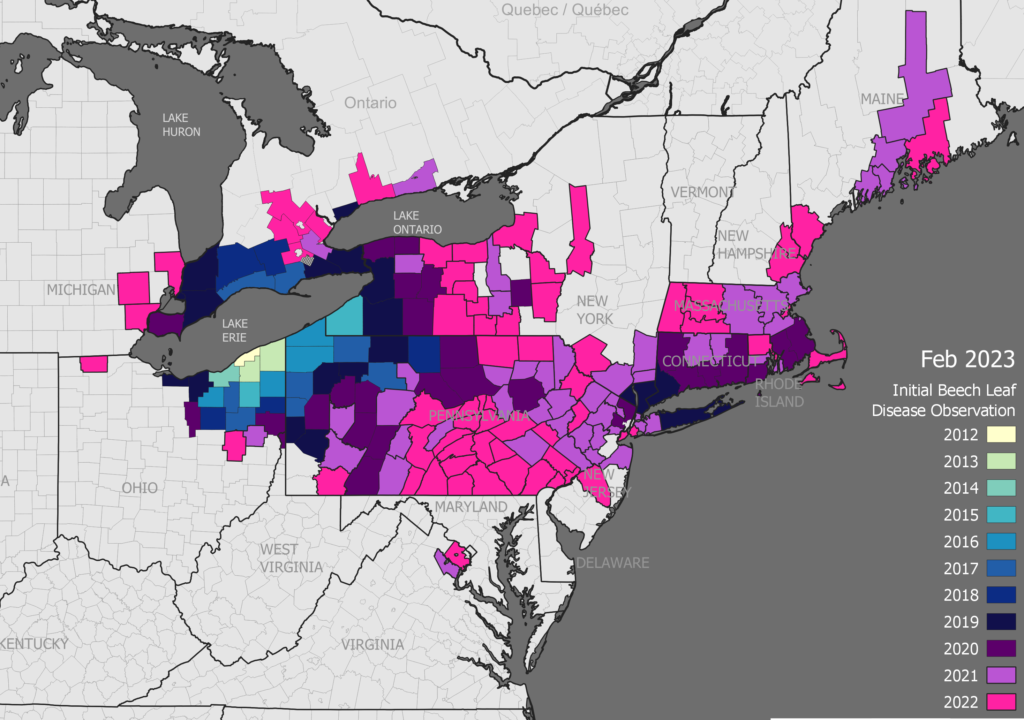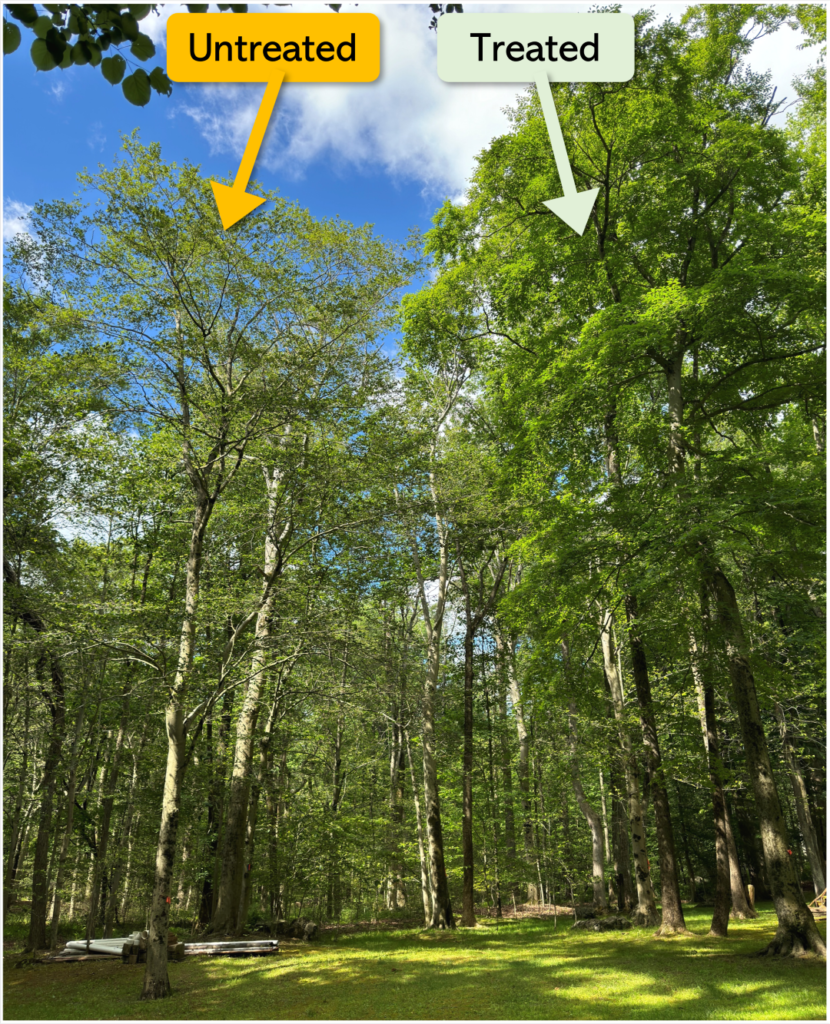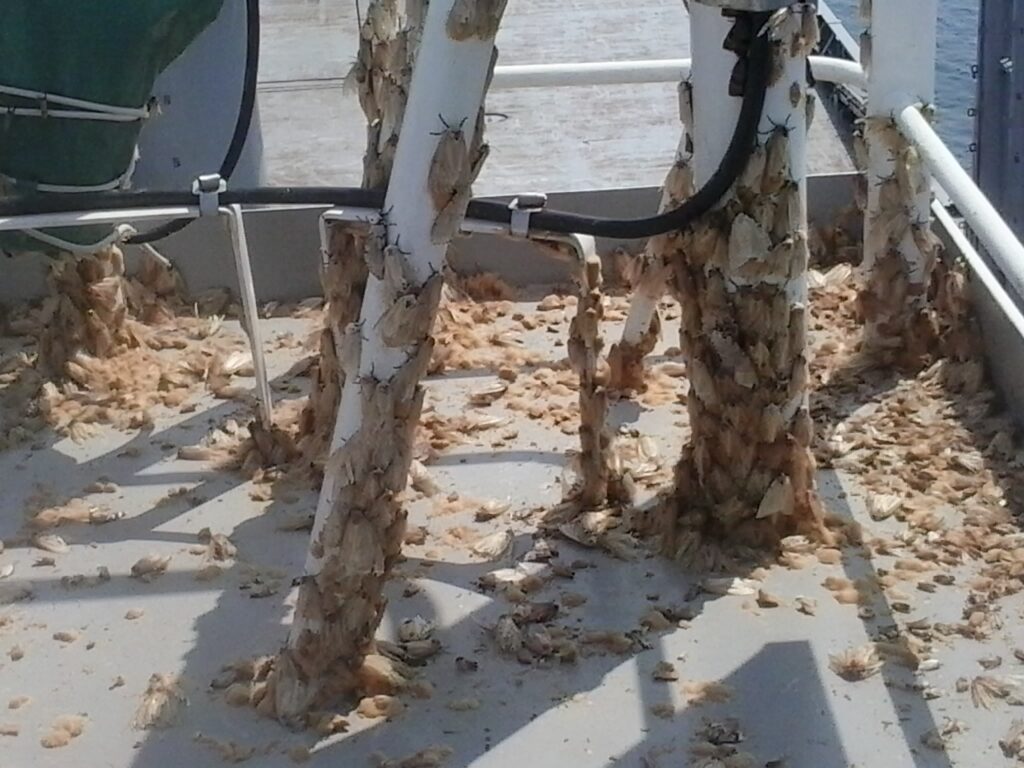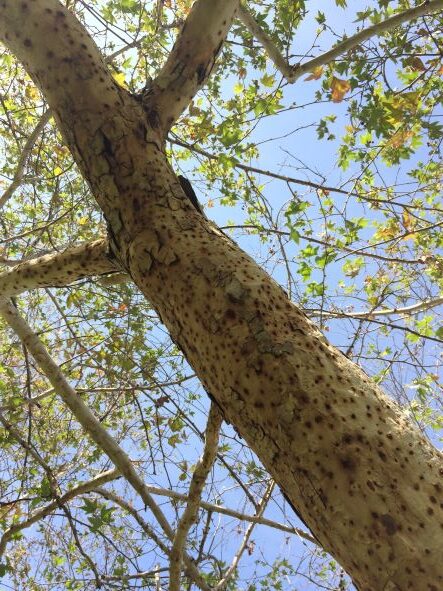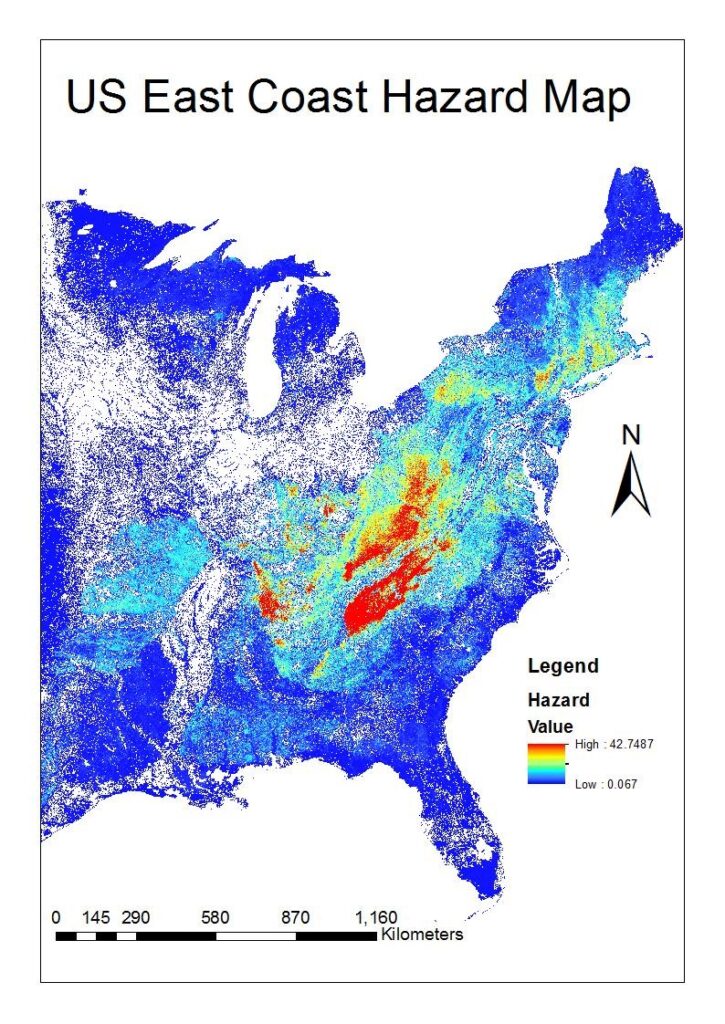As beech leaf disease (BLD) is detected in an ever-expanding number of counties from Michigan to Maine south to Virginia, scientists are trying to clarify how the causal nematode — Litylenchus crenatae ssp. mccannii (Lcm) – spreads. One focus is on local spread from tree to tree. Mankanwal Goraya and colleagues set up an experiment in Stone Valley Forest, a recreation and research site managed by Penn State in Huntington County, Pennsylvania. BLD is present – although I have not been able to determine for how many years. [The full citation to Goraya et al. is provided at the end of this blog.]
Goraya et al. (2024) set up four stands, each bearing three funnels, at varying distances from naturally BLD-infected American beech (Fagus grandifolia) trees. Two stands were at 3.51 m from symptomatic trees of starkly different sizes: one of the trees had a dbh of 50 cm, the other of only 5.6 cm. A third close-up stand was set up at 2.20 m from another large tree, having a dbh of 46 cm. The fourth stand was set up at a significantly longer distance, 11.74 m from a symptomatic beech tree; this tree was also small, with a dbh of 5 cm. This arrangement allowed the scientists to detect influences of both distance from the source of infection and relative canopy size of the source tree. They consider dbh to be an adequate substitute for canopy size. There was apparently no other effort to determine or vary the height of “source” trees, although I think that might influence speed of the wind flowing through the canopy.
Goraya et al. also tested whether it is possible to detect the presence of Lcm in association with other invertebrates that live in beech forests. To do this, they counted numbers of nematodes in frass from six species of caterpillars that had been feeding on leaves of infected trees, and in two spider webs spun in the branches of symptomatic trees. They also determined whether these nematodes were alive (active) or inactive – presumably dead.
The study makes clear that Lcm’s life cycle and impact are not as surprising as initially thought. Several species in the family Anguinidae – to which Lcm belongs – are considered significant pests. These nematodes can parasitize aerial parts of the plants (leaves, stems, inflorescences and seeds), causing swellings and galls. Furthermore, they are migratory; they can move across the surface of host tissues using water films. Once they have penetrated the host tissues, they can induce host cell hyperplasia and hypertrophy, resulting in leaf or bulb deformities, shorter internodes, and neoplastic tissues. Furthermore, heavy rainfall and wind are known to play significant roles in the dissemination of plant-infecting nematodes. In their desiccated state on infected seeds, some species of this family can survive passage through animals’ gastrointestinal digestive tract (e.g., domestic livestock, insects, & birds).
A crucial factor is that Lcm can reach densities of thousands of nematodes per leaf by late summer or early fall, increasing the likelihood of their exposure to facilitating environmental conditions at the time they migrate from leaves to buds. And once established within the bud tissues, the nematodes feed on bud scales and newly forming leaves to develop & increase their pop #s. They also use the bud as protection from adverse environmental conditions.
Goraya and colleagues collected samples every other day from September 9 to November 23, 2023 – the period when Lcm migrate from highly infected leaves to newly forming buds. [I note that it in the mid-Atlantic – where Lcm is spreading – we had an extensive drought in autumn 2024 – more than 30 days without any rain from early October into November. I hope scientists are monitoring BLD spread sufficient closely to see whether this drought affected dispersal.]
Nematodes dispersal linked to weather
Goraya and colleagues collected 324 samples from the funnels. Eighty-two percent (n =266) of the samples had nematodes; up to 92% were identified as Lcm. Non-Lcm nematodes were distributed across different genera, mostly classified as free-living nematodes. While several hundred nematodes were found in the funnels on most days, numbers peaked noticeably on some days in September and October. A startling 2,452 nematodes were recovered from a single funnel in October. Depending on the sample, up to 67% of Lcm recovered from the funnels were active.
Analysis of the environmental (weather) variables found that increases in wind speed, humidity, and precipitation (rainfall) coincided with higher numbers of Lcm being recovered from the funnels. However, the effect of wind speed becomes less positive as precipitation increases or vice versa. Goraya et al. suggest a pronounced negative interaction between wind and rain. At low precipitation levels, increased wind speed might facilitate Lcm dispersal. As rainfall increases, higher wind speeds might carry the Lcm nematodes farther away. Support is seen in the fact that fewer nematodes were found in the funnels closer to the BLD-infected trees during these periods. Really heavy rain might push a significant preponderance of nematodes to the ground. The scientists point to a very complex interplay between weather patterns and Lcm population dynamics and dispersal.
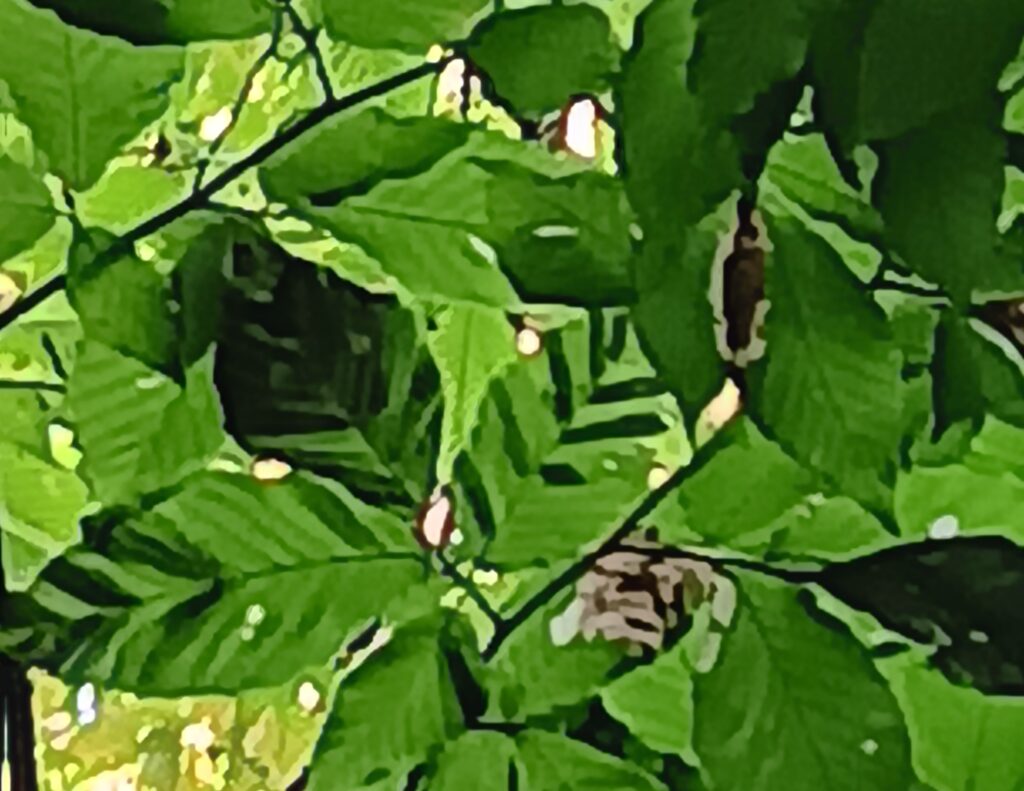
The model did not show any significant influence of maximum temperature on nematode numbers in autumn. Goraya et al. do not speculate on whether temperatures might play a role during summer, as distinct from cooler autumn periods.
Goraya et al.’s findings differ from those of previous studies. Earlier documentation of wind dispersal of nematodes concerned primarily free-living species. It was unexpected to find consistently much higher numbers of Lcm – especially because Lcm is a plant-parasitic nematode. Another surprise is the high proportion of nematodes that are active.
Goraya et al. conclude that because Lcm is actively migrating in large numbers during autumn months, it is primed to take advantage of favorable weather. This nematode will likely survive and thrive in the environmental conditions of beech forests in northeastern North America.
Considering the effect of distance, some findings fit expectations: significantly more Lcm were recovered from funnels placed near symptomatic “source” trees than from those farther away. However, this was not a simple relationship. For example, in two cases the scenarios seemed nearly alike: both “source” trees were large (dbh 46 or 50 cm) and symptoms were “medium-high” (more than half of leaves presenting dark-green interveinal bands). Distance of funnels from the “source” tree differed minimally: 2.2 m versus 3.51 m. Still, the number of nematodes retrieved from the two sets of funnels differed significantly: one set of funnels recovered the highest number of Lcm nematodes obtained during the entire experiment – 2,452; the second contained only up to 600 nematodes. The authors do not offer an explanation.
I am not surprised by the apparently strong correlation between numbers and proximity to the disease source (a symptomatic tree). Nor am I surprised that Lcm nematodes were also found in funnels 11 meters away. I do wonder, however, why they are certain that no source was closer. Detecting early stage infections is notoriously difficult.
Goraya et al. also evaluated the effect of size of the source tree. They used dbh a substitute for larger canopies. Trees with larger canopies can host more nematodes, so are likely to contribute more to dispersal events. Two sets of funnels were equidistant from separate “source” trees – 3.51 m. One tree was small – 5.6 cm dbh, 11% as large as the other tree (50 cm). They collected many fewer Lcm nematodes from the smaller tree – the maximum was only 132 compared to 600 (a decrease of 78%).
Still, small trees can apparently support spread of the nematode to a reasonable distance. The fourth set of funnels was set up more than three times farther away (11.74 m) from an infected tree of a similar size (dbh = 5 cm) but recovered almost the same number of Lcm nematodes (0 – 119).
I find it alarming that both small trees in this part of the experiment had low BLD symptoms – only a few leaves were banded. Yet they apparently are the source of Lcm spread. The alternative, as I noted above, is that other “source” trees were in the vicinity but were not detected, possibly because they did not yet display symptoms?
Goraya et al. conclude that “source” tree size directly impacts the number of recovered nematodes. In addition, wind plays a pivotal role in their local distribution. This suggests a complex dispersal pattern in which proximity to the source leads to higher numbers of nematodes but longer-distance spread is possible.
Nematodes’ association with other organisms
Goraya et al. (2024) collected one each of six caterpillar species from BLD-symptomatic trees. The frass of one – the tussock moth caterpillar (Halysidota tessellaris) — contained 12 nematode specimens — 10 of them Lcm. Two of the Lcm were alive and active. Their presence indicates that Lcm can survive passage through the caterpillar’s gastrointestinal tract. The authors conclude that caterpillars feeding on symptomatic leaves might contribute to local dispersal of Lcm.
Hundreds of Lcm were recovered from the two spider webs collected from the branches of a BLD-infected beech tree. From one web, 255 nematodes were captured; 58 were active. In the second web there were only 34 Lcm, but one-third — 10 – were active.
Goraya et al. (2024) hypothesized that any biotic form having the ability to move from a BLD-infected tree would be able to transport Lcm to other non-infected trees. Beyond caterpillars, they speculate that birds consuming these caterpillars might also disperse Lcm. Doug Tallamy has documented that many birds feed on caterpillars, link although he is focused on those that consume caterpillars in the spring, not the autumn. They note that others are studying that the bird species that feed on beech buds (e.g., finches) might transport nematodes. They note the need for additional research to clarify whether the nematode can survive birds’ digestive system.
Re: detection of live Lcm in spider webs, Goraya et al. suggest two possible interpretations: 1) this finding demonstrates that nematodes might fall from leaves, potentially spreading the infection to other trees beneath the canopy. (Supporting this idea is the fact that sub-canopy trees are often heavily infected with BLD and are frequently the first to exhibit BLD symptoms.) 2) Nematodes in spider webs are very likely to be transported by other “incidental organisms” (e.g., insects, birds, mammals) that feed on invertebrates trapped in webs — thereby potentially increasing the number and impact of nonspecific nematode vectors.
In conclusion, Goraya et al. found that many factors, e.g., distance & size of infected beech trees, wind speed, & humidity, contribute significantly to Lcm dispersal. The multitude of organisms interacting beneath the canopy also play a role.
They suggest that several major questions still need to be explored. These include how Lcm navigate environmental factors in their spread; and whether Lcm can survive – perhaps in a anhydrobioses state –transport over long distances, whether by abiotic or biotic vectors.
I remind my readers of the importance of beech in the hardwood forests in northeastern North America. Many wild animals, including squirrels, wild turkeys, white-tailed deer, and bears depend on beechnuts for fats and proteins. Moreover, some insects birds rely on beech tree canopies for shelter & nesting.
Other Hosts
Beech leaf disease attacks not just American beech (Fagus grandifolia). In North America, it has also attacked planted European beech(F. sylvatica), Chinese beech (F. engleriana), and Oriental beech (F. orientalis). Thus if it spreads it could have severe impacts across forests of much of the Northern Hemisphere.
I appreciate that this project was funded by the USDA Forest Service International Program. I will pursue information concerning efforts by USFS Research and Development and the Forest Health Protection program.
SOURCE
Goraya, M., C. Kantor, P. Vieira, D. Martin, M. Kantor. 2024 Deciphering the vectors: Unveiling the local dispersal of Litylenchus crenatae ssp mccanni in the American beech (Fagus grandifolia) forest ecosystem PLOS ONE |https://doi.org/10.1371/journal.pone.0311830 November 8, 2024 1 / 16
Posted by Faith Campbell
We welcome comments that supplement or correct factual information, suggest new approaches, or promote thoughtful consideration. We post comments that disagree with us — but not those we judge to be not civil or inflammatory.
For a detailed discussion of the policies and practices that have allowed these pests to enter and spread – and that do not promote effective restoration strategies – review the Fading Forests report at https://treeimprovement.tennessee.edu/
or
















